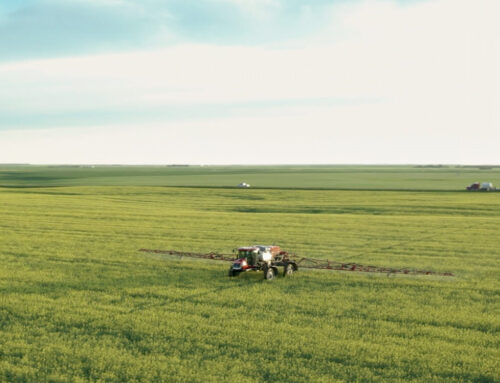How To Stretch Your Glyphosate Use Without Reducing Your Weed Control This Year


With glyphosate potentially in short supply this year, what can farmers do to stretch the amount of product they have? Below are some tips to make your pre-seed glyphosate go further.
1. Scout your fields to determine if pre-seed herbicide is required.
- If a field had an application of glyphosate or 2,4-D late last fall, there is a good possibility that the field will be clean this year and pre-seed herbicide is not required.
- With the dry conditions in many areas last year, there may be little weed growth prior to seeding this year, in which case a pre-seed herbicide application would not be required.
- Consider spot-spraying in situations where weeds are in patches only. AUGMENTA technology can help reduce inputs costs – click here for information on AUGMENTA. Augmenta – Agracity Crop & Nutrition
2. Is glyphosate the right solution for your weed control needs?
- If broadleaf weeds are the primary concern there are different pre-seed products that can provide excellent broadleaf control when used alone.
- If grass weeds such as quackgrass and wild oats are the major concern then glyphosate may still be required, but 0.5 L/acre REL equivalent should be sufficient for control of quackgrass and wild oats.
- Consider products with some residual. For spring wheat, AgraCity products like HIMALAYA EXTRA herbicide and HIMALAYA PASS herbicide can provide excellent pre-seed wild oat suppression with some residual control to keep fields cleaner for longer.
3. Use lower rates of glyphosate.
- Check the glyphosate label and match the rate with your needs. For many small grass and broadleaf weeds, a low rate of glyphosate may be all that is needed for good control, which can allow you to save glyphosate for weeds that need higher application rates such as foxtail barley.
4. Skip the glyphosate or add a tank mix partner .
- There are many different pre-seed herbicides that can provide excellent weed control both with or without the use of glyphosate.
- AgraCity has a number of different pre-seed herbicides for every acre that you farm.
- Cereal crops: AMMO®, AMMO EXTRA, BATTLEFRONT®, HIMALAYA™ EXTRA, HIMALAYA PASS, MPOWER® EXTRA, PILOT™, REVENGE™ AE,
- REVENGE E and REVENGE PRO herbicides all provide outstanding weed control for many different broadleaf weeds.
- Pulse crops: REVENGE herbicide is a great choice for control of tough to kill broadleaf weeds.
- Canola crops: Consider INDEPENDENCE® or QUIZ® herbicides if grass weeds are an issue, or glyphosate alone if broadleaf weed control is required.
- Some pre-seed products required adjuvant if used alone or with low rates of glyphosate. See individual product labels for required rates of adjuvant.
- Click here to see the full list of AgraCity pre-seed products.
5. Check your water quality.
- Glyphosate is sensitive to water quality; hard water or water containing calcium (Ca+), magnesium (Mg+), or iron (Fe+), or dirty water or water with suspended soil or organic matter will reduce control. If there have been water quality issues in the past, if you are not sure about your quality, or if you know that you have hard water, consider adding a water conditioner. Hard water can tie up glyphosate, so adding a water conditioner may help you get comparable results at a lower rate of glyphosate than you have traditionally used.
6. Maintain water volume and application rates.
- Water volumes. It is important to maintain your water volumes for pre-seed application, as many weeds are likely small, plus growth may be slower due to cool temperatures. This is especially important if you are applying a contact herbicide where coverage is critical to maintain performance.
- Application rates. As with water volume, application rates are important to maintain performance. Do not cut back rates below label recommendations as performance can be reduced.
7. Consider adding a surfactant instead of using higher rates.
- If you are spraying in stress conditions such as cold and/or dry conditions, consider adding a surfactant instead of using higher rates. A good all round non-ionic surfactant such as Agral® 90 or equivalent is a good option.
8. Avoid waste at start-up, filling and cleaning.
- Instead of overfilling the sprayer and dumping out the un-used product, consider a metering device to help get the right amount of water in the sprayer tank.
- If possible, avoid too much product being sprayed out at start up and cleanout.
- Try to minimize spray overlaps once you start application.
9. Change up management practices.
- Consider pre-seed tillage if you are in an area with low risk of soil erosion.
- Choose a crop that is a strong competitor to weeds:
– Cereal and canola crops are stronger competitors than pulse crops.
– Scout fields before spraying to determine the extent of the problem. - Maximize crop competitiveness using good agronomic practices:
– Use high quality seed and increase seeding rates.
– Narrower row spacing.
– Place fertilizer to benefit your crop.
– Seed earlier for better crop competition.
Want to speak to an experienced agronomist?
Call the AgraCity Agronomic Support Line at 1-833-832-7637.
AMMO®, BATTLEFRONT®, HIMALAYA™, INDEPENDENCE®, MPOWER®, PILOT™, QUIZ® and REVENGE™ are trademarks of AgraCity or its affiliates.
All other products are trademarks of their respective holders.












